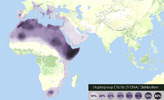I've been mulling over the origins of the Proto-Afroasiatic language family for a while and found it strange how no real consensus seemed to be reached amongst linguists and scholars. Looking at the evidence, supporters of a West Asian origin believe the Natufians who lived in the Levant were the speakers of Proto-Afroasiatic and cite common agricultural terms such as flora and fauna names within the lexicon and that Afroasiatic expanded with the spread of farming which mirror what happened with Niger-Congo and Austroasiatic language families. There is also the fact that Afroasiatic is strongly correlated with Natufian/Arabian like DNA and with the exception of Omotics, all Afroasiatic speakers carry significant amounts of Natufian DNA.
On the other hand, there are those who propose that the Horn of Africa is an origin site as well. The main argument there is that E1b1b, the haplogroup associated with Afroasiatics originated in East Africa and the oldest and most diverse subclades can only be found there as well.
So what do you think? What is the most likely location for proto-Afroasiatic?
@Step a side @NidarNidar @Khaemwaset @The alchemist
On the other hand, there are those who propose that the Horn of Africa is an origin site as well. The main argument there is that E1b1b, the haplogroup associated with Afroasiatics originated in East Africa and the oldest and most diverse subclades can only be found there as well.
So what do you think? What is the most likely location for proto-Afroasiatic?
@Step a side @NidarNidar @Khaemwaset @The alchemist

